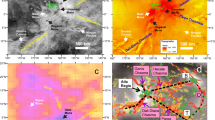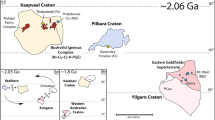Abstract
The Bushveld Complex in South Africa represents the world’s largest intrusion of magnesium- and iron-rich magmas. The Bushveld magmas were emplaced beneath the Transvaal basin1 ∼2.06 billion years ago2,3, but their origin remains elusive. The magmas may have formed in response to an upwelling mantle plume4, ancient subduction5 or melting triggered by a meteorite impact6. Here we use U–Pb dating of baddeleyite crystals to date a series of mafic magmatic dykes located east of the Transvaal basin. We find that these dykes formed between 2.70 and 2.66 billion years ago, roughly 600 million years before the Bushveld magmas were emplaced. Collectively, the geometry of the dykes forms a radiating swarm converging towards a focal point in the eastern part of the Bushveld Complex. Such radiating swarms typically record the impact of a mantle plume head that injected large volumes of magma into the crust and at the base of the lithosphere. We propose that subsequent cooling and metamorphism of these mantle-plume-derived rocks caused them to increase in density and sink, triggering subsidence of the Transvaal basin. The dense rocks may later have sunk away into the mantle, with the delamination causing the inflow of hot mantle that initiated production of the voluminous Bushveld magmas about 600 million years after the mantle plume impact.
This is a preview of subscription content, access via your institution
Access options
Subscribe to this journal
Receive 12 print issues and online access
$259.00 per year
only $21.58 per issue
Buy this article
- Purchase on Springer Link
- Instant access to full article PDF
Prices may be subject to local taxes which are calculated during checkout



Similar content being viewed by others
References
Harney, D. M. W. & von Gruenewaldt, G. Ore-forming processes in the upper part of the Bushveld complex, South-Africa. J. Afr. Earth Sci. 20, 77–89 (1995).
Scoates, J. S. & Friedman, R. M. Precise age of the platiniferous Merensky Reef, Bushveld Complex, South Africa, by the U–Pb zircon chemical abrasion ID-TIMS technique. Econ. Geol. 103, 465–471 (2008).
Olsson, J. R., Söderlund, U., Klausen, M. B. & Ernst, R. E. U–Pb baddeleyite ages linking major Archean dyke swarms to volcanic-rift forming events in the Kaapvaal craton (South Africa), and a precise age for the Bushveld Complex. Precambr. Res. 183, 490–500 (2010).
Hatton, C. J. Mantle plume origin for the Bushveld and Ventersdorp magmatic provinces. J. Afr. Earth. Sci. 21 (4), 571–577 (1995).
Clarke, B., Uken, R. & Reinhardt, J. Structural and compositional constraints on the emplacement of the Bushveld Complex, South Africa. Lithos 111, 21–36 (2009).
Rhodes, R. C. New evidence for impact origin of the Bushveld Complex, South Africa. Geology 3, 549–554 (1975).
de Wit, M. J. et al. Formation of an Archaean continent. Nature 357, 553–562 (1992).
Cawthorn, R. G. & Walraven, F. Emplacement and crystallization time for the Bushveld Complex. J. Petrol. 39, 1669–1687 (1998).
Lee, C. A. in Layered Intrusions (ed. Cawthorn, R.G) 103–145 (Elsevier, 1996).
Harris, C., Pronost, J. J. M., Ashwal, L. D. & Cawthorn, R. G. Oxygen and hydrogen isotope stratigraphy of the Rustenburg layered suite, Bushveld Complex: Constraints on crustal contamination. J. Petrol. 46, 579–601 (2005).
Richardson, S. H. & Shirey, S. B. Continental mantle signature of Bushveld magmas and coeval diamonds. Nature 453, 910–913 (2008).
James, D. E., Fouch, M. J., VanDecar, J. C., van der Lee, S. & Kaapvaal Seismic Group, Tectospheric structure beneath southern Africa. Geophys. Res. Lett. 28, 2485–2488 (2001).
Carlson, R. W. et al. Continental growth, preservation and modification in southern Africa. GSA Today 10, 1–7 (2001).
Letts, S., Torsvik, T. H., Webb, S. J. & Ashwal, L. D. Palaeomagnetism of the 2054 Ma Bushveld Complex (South Africa): Implications for emplacement and cooling. Geophys. J. Int. 179, 850–872 (2009).
Barnes, S. J. Are Bushveld U-type parent magmas boninites or contaminated komatiites? Contrib. Mineral. Petrol. 101, 447–457 (1989).
Uken, R. & Watkeys, M. K. An interpretation of mafic dyke swarms and their relationship with major mafic magmatic events on the Kaapvaal Craton and Limpopo Belt. South Afr. J. Geol. 100, 341–348 (1997).
Elkins-Tanton, L. T. Continental magmatism caused by lithospheric delamination. Spec. Pap. Geol. Soc. Am. 388, 449–461 (2005).
Willmore, C. C., Boudreau, A. E., Spivack, A. & Kruger, F. J. Halogens of Bushveld Complex, South Africa: δ37 Cl and Cl/F evidence for hydration melting of the source region in a back-arc setting. Chem. Geol. 182, 503–511 (2002).
Harmer, R. E. & von Gruenewaldt, G. A review of magmatism associated with the Transvaal Basin — implications for its tectonic setting. South Afr. J. Geol. 94, 104–122 (1991).
Buchanan, P. C. & Reimold, W. U. Studies of the Rooiberg group, Bushveld Complex, South Africa: No evidence for an impact origin. Earth Planet. Sci. Lett. 155, 149–165 (1998).
Ernst, R. E. & Buchan, K. L. in Mantle Plumes: Their Identification Through Time Vol. 352 (eds Ernst, R. E. & Buchan, K. L.) 247–265 (Geological Society of America Special Paper, 2001).
Eriksson, P. G., Altermann, W., Catuneanu, O., van der Merwe, R. & Bumby, A. J. Major influences on the evolution of the 2.67—2.1 Ga Transvaal basin, Kaapvaal craton. Sedim. Geol. 141–142, 205–231 (2001).
Klausen, M. B. et al. Petrological discrimination among dated Precambrian dyke swarms, Eastern Kaapvaal craton (South Africa). Precambr. Res. 183, 501–522 (2010).
Lubnina, N., Ernst, R. E., Klausen, M. B. & Söderlund, U. Paleomagnetic study of Neoarchean-Paleoproterozoic dykes in the Kaapvaal Craton. Precambr. Res. 183, 523–552 (2010).
McCarthy, T. S, McCallum, K., Myers, R. E. & Linton, P. Stress states along the northern margin of the Witwatersrand Basin during Klipriviersberg Group volcanism. South Afr. J. Geol. 93, 245–260 (1990).
Wright, C. Station corrections for the Kaapvaal seismic network: Statistical properties and relation to lithospheric structure. Phys. Earth Planet. Inter. 167, 39–52 (2008).
Kaminski, E. & Jaupart, C. Lithosphere structure beneath the Phanerozoic intracratonic basins of North America. Earth Planet. Sci. Lett. 178, 139–149 (2000).
Mapeo, R. B. M., Armstrong, R. A. & Kampunzu, A. B. SHRIMP U–Pb zircon geochronology of gneisses from the Gweta borehole, northeast Botswana: Implications for the Palaeoproterozoic Magondi Belt in southern Africa. Geol. Mag. 138, 299–308 (2001).
Holzer, L., Frei, R., Barton, J. M. & Kramers, J. D. Unravelling the record of successive high-grade events in the Central Zone of the Limpopo Belt using single phase dating of metamorphic minerals. Precambr. Res. 87, 87–115 (1999).
Elkins-Tanton, L. T. & Hager, B. H. Melt intrusion as trigger for lithospheric foundering and the eruption of the Siberian flood basalts. Geophys. Res. Lett. 27 (23), 3937–3940 (2000).
Webb, S. J., Ashwal, L. D. & Cawthorn, R. G. Continuity between eastern and western Bushveld Complex, South Africa, confirmed by xenoliths from kimberlites. Contrib. Mineral. Petrol. 162, 101–107 (2011).
Acknowledgements
We acknowledge funding from the Crafoord Foundation and the Swedish Research Council via grants to U.S. We thank W. L. Griffin for constructive comments that improved the manuscript. Thanks to D. Conley at Lund University for commenting on the manuscript and linguistic help. J.R.O. thanks the laboratory staff at the Jack Satterly Geochronology Laboratory for assistance during his visit in 2009.
Author information
Authors and Affiliations
Contributions
M.B.K. and U.S. initiated the study and sampled the targeted dolerite dykes. J.R.O. processed the dyke samples and extracted the baddeleyite separates. M.A.H. and J.R.O. performed the U–Pb ID-TIMS analyses at the Jack Satterly Geochronology Laboratory, University of Toronto. G.R.H. provided important re-interpretations of published seismic data. J.R.O. and U.S. wrote the paper. All authors discussed the results and commented on the manuscript.
Corresponding author
Ethics declarations
Competing interests
The authors declare no competing financial interests.
Supplementary information
Supplementary Information
Supplementary Information (PDF 368 kb)
Rights and permissions
About this article
Cite this article
Olsson, J., Söderlund, U., Hamilton, M. et al. A late Archaean radiating dyke swarm as possible clue to the origin of the Bushveld Complex. Nature Geosci 4, 865–869 (2011). https://doi.org/10.1038/ngeo1308
Received:
Accepted:
Published:
Issue Date:
DOI: https://doi.org/10.1038/ngeo1308
This article is cited by
-
Magma Generation of Magnetite-Rich Intermediate-Mafic Rocks and Its Mantle Processes in the Southwestern Alxa Block, NW China
Journal of Earth Science (2022)
-
Plate tectonics on the Earth triggered by plume-induced subduction initiation
Nature (2015)
-
Zircon Hf isotope evidence for an enriched mantle source for the Bushveld Igneous Complex
Contributions to Mineralogy and Petrology (2014)
-
The Bushveld Complex, South Africa: formation of platinum–palladium, chrome- and vanadium-rich layers via hydrodynamic sorting of a mobilized cumulate slurry in a large, relatively slowly cooling, subsiding magma chamber
Mineralium Deposita (2013)



